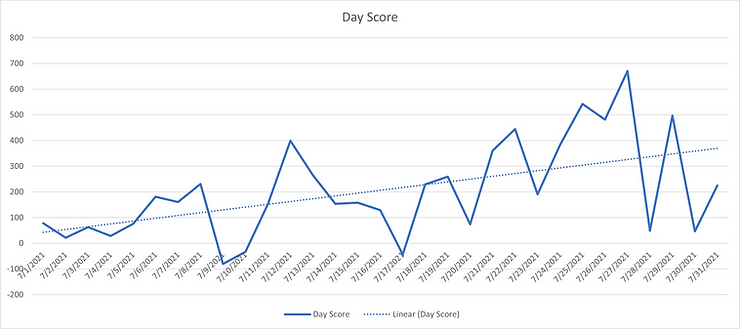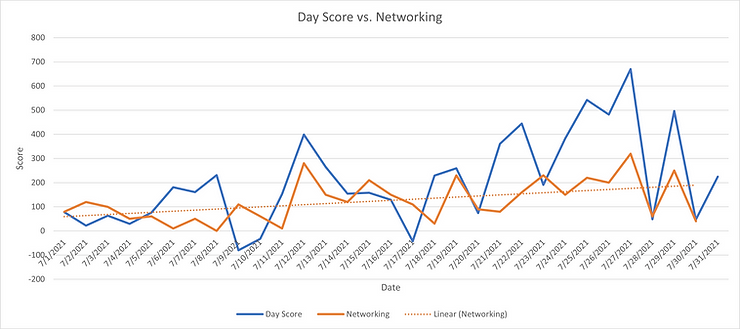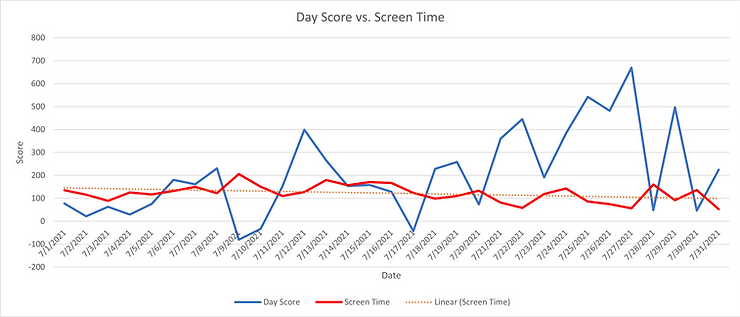How I Became 956% Better in 45 Days
Scoring my days to make massive improvements in my life.
*Editor’s Note: This blog was the follow-up to my Carpe Diem blog. Both were written about 2 years ago. I have just recently re-started examining my day scores after falling off the habit. The following is the effect that Day Scores had on my life 2 years ago.*
One June 21, 41 days ago, I posted a blog called Carpe Diem and How to Measure It. It began with this quote:
“We have two lives, and the second begins when we realize we only have one.” ― Confucius
I said that I had discovered my second life had begun in college when I first made the concession that life ends once you die. I began treating each day with more appreciation. I mentioned at the end that I was going to experiment with this new system called the Day Score. I was going to use certain metrics I devised for myself to judge how effectively I was spending my time.
If my second life had begun back in college, my third life has now begun after implementing the Day Score.
What I Set Out to Do
We all try to gauge at what point you are old. Of course, it is all relative. But we all have our own ideas of when youth ends. My dad met my mom when he was twenty-five. That was always the bar for me. Up until that point, I told myself that I knew I was still young. I had time to meet the woman I would marry. My whole life would be ahead of me until I turn twenty-five. Beyond that point, I had a sense that things would change just as they did for my dad.
However, I turn twenty-five in forty-six days. If my goal is to live to 100, a quarter of it has already passed. And I’ll be honest, I haven’t impressed myself. In Carpe Diem and How to Measure It, I said this:
“We have all heard of the term carpe diem. We all understand it to mean ‘seize the day’. However, how many of our days are we actually seizing? For me, the answer is very few. I waste time scrolling through Instagram mindlessly and watching YouTube videos that teach me nothing. There is little sense of urgency to break bad habits and to form new, good habits.”
I wanted to stop the cycle of believing that my days are not numbered. That I have time to fix the things that need fixing and build the things that need building. The truth is, I don’t.
I also wanted a way to reflect on my day. I don’t want my days to pass and for me to not appreciate them afterwards. Many people turn to journaling for this. My handwriting sucks and I never found the practice all that compelling. I like data. So why not use data as a medium for reflection?
“If you were to look upon yesterday, pretending it was your last, what would you think?” I asked myself. But without any real metrics to analyze, it was hard to say. Sure, I could look at yesterday and think about that dinner date I went on and say ‘That was a swell time.’ But that is too subjective. If that was my last day here on the Earth, could I really say with confidence that it was well lived?
I also wanted a way to analyze if I was accomplishing the proverbial ‘get 1% better every day’ shtick. That seems like a simple thing to accomplish, right? 1% doesn’t seem like a lot. But how much is 1%? 1% of what, exactly?
I needed a system that could tell me how much 1% is. Something to help me operate more lucidly. A means of reflection. A system that could provide me with data. A system that could encourage me to value the day and not the tomorrow.
That system I created is the Day Score. The Day Score is a simple value system that creates a way to score your day. And it works. Using the Day Score, I didn’t just get 45% better over 45 days. I got 956% better.
And I have the data to prove it.
My Day Score
Here is my Day Scores from July 1st to July 31st. I’m not including the few days I did in June simply because creating the graphs in Excel was a pain in the ass. But, when you look at the dotted line, the trendline for the data, you’ll see it goes up. And quite a lot.
My first Day Score was a -43.82 on June 17th. Without changing the goal posts too much, my trendline ends in July at about 375. That’s a 956% improvement. My high score, on July 27th, was 670.01. And this wasn’t because I was fudging the numbers to make myself feel better. These are genuine improvements. The metrics I chose have real added value to my life. And I can honestly say my life is significantly better today than it was 45 days ago. I’m happier. More productive. Have met more people. And have made significant progress in my career. This was all measured.
An interesting pattern to note in the data is the fluctuations that you see. After every peak, there is a subsequent valley. I can explain these subjectively as well as objectively. Subjectively, I found days following a peak to be moments where I was less motivated to have a high score day. That is because a high score day is taxing. It means hard workouts, a lot of interpersonal communication, and a lot of productive work. I am human, not a robot. Constant progress is hard. Possible, but challenging.
However, if you follow the trend over time, the peaks are higher, and the valleys are higher. My good days are better than the previous ones. My bad days are better than the priors. Despite the lower score days, the trend is overwhelmingly positive.
There are also some correlations I was able to discover that make me more aware of how to capitalize on a day. This is even if I have little energy to be productive.
One of the things I track is my networking volume. This is literally just how many people I direct messaged on Instagram and Twitter in a day. It’s something that is super easy for me to do. It has brought me fantastic new connections which I will leverage for my new company.
You can see that every peak in my Day Score is accompanied by a peak in networking volume. The same is true with the valleys. Networking always translates to the following day. I gain new followers, a larger community, and more people viewing the content I publish that I work hard to create. So, if I want to have a good day even when I’m not feeling super motivated, sending out a few DMs can do the trick!
Another thing I tracked was my phone screen time. I am in a constant war with my phone, as many of us are. I want to stay away as often as possible. I frequently find myself getting dragged into its dopamine filled depths. I always figured that my worst days came when I used my phone the most. And that couldn’t be truer. You can see an inverse relationship here between screen time and my Day Score. When the score is high, the screen time is low. When the score is low, I was on my phone staring into the abyss for far too long.
Habits Gained and Lost
The Day Score allowed me to do exactly what I have wanted to do forever. It gave me the ability to add and eliminate many habits at a time with high efficacy. Previously, I had used a streak system. I would tally the number of days that I consistently completed a new, good habit or the number of days I didn’t do a bad habit. The issue with this system is if you mess up one day, you lose your streak. Here is why that is an issue:
Let’s say you are a smoker and want to give up smoking. You stop for a week and are feeling pretty good. You also really don’t want to smoke again because then you’ll lose your weeklong streak. The longer the streak gets, the more you are motivated to keep it going. Soon enough, you haven’t smoked for six months. You are all but ready to call yourself a non-smoker. Unfortunately, one night you have a bit too much to drink. On the back patio with a drink in your hand, you grab one of your friends cigarettes.
The next day you wake up with the foggy memory of having a cigarette and realize the six-month streak you had worked so hard to build is now gone. What’s the harm in buying a pack now if there is nothing to lose? You head down to the convenience store and buy a pack for the first time in six months.
You might think I’m being dramatic. But I watched my mom, who has now officially quit smoking, go through this cycle my whole life.
I tried streaks for everything. The day I lost a streak because I wasn’t consistent enough, I would binge the bad habit or not partake in the good habit until I found the motivation again. That did not happen once with the Day Score. If a partook in a bad habit, I didn’t fall off the wagon completely. I had structured the scores in such a way that that bad habit was reflected in a terrible score. The next day, I would try to set a record. I couldn’t do that with the bad habit in the way. You can see these valleys in the data followed by new peaks.
I also scored new, good habits in such a way that doing them was reflected greatly in my score. Each day, I was highly motivated to stick with them. My competitive nature wanted to beat the me of yesterday.
Here are some habits I have gained and lost throughout the last forty-five days:
Habits Gained
· I now brush my teeth three times a day and floss my teeth twice. I used to just brush my teeth in the morning and sometimes at night. I would hardly ever floss. I am now diligent about taking better care of my teeth. It turns out you only get one set.
· I used to lay in bed for twenty to thirty minutes every morning on my phone. It was a ton of wasted time. I would have to rush in the morning before getting to work as a result. Now I get out of my bed right as the alarm wakes me up.
· I have gained over 100 followers on Twitter just by committing myself to networking more. I have gained some valuable relationships in a short time span as a result. This is incredibly valuable to the business I am starting.
· I began working out more consistently. As I was slowing down my training business, my workouts were declining in quality. Since the Day Score, I have achieved numerous personal records on the rower and am stronger and more mobile.
Habits Eliminated
· I think porn is terrible for a males sexual health. It’s also something many men are addicted to. I have tried to quit watching porn for years. In the past forty-five days, I have watched it twice.
· On July 31st, I spent only 5 minutes scrolling mindlessly through Instagram. In the beginning of this experiment, I was spending an hour-plus. I have given myself time back that was previously wasted on nothingness.
· I used to eat a dessert every day. It might have been a couple of cookies or a brownie. I didn’t think I had a bad relationship with food until I realized what as was doing with the help of the Day Score. Now, I have one cheat item a week. I have lost 1% body fat in the past two weeks alone.
Unintended Benefits and Gaining Awareness
I hoped I would gain awareness through this process. I hoped I would gain an appreciation of every moment I was spending. I intended to observe every moment and be able to accurately answer whether or not that moment was high or low value. The Day Score system has provided that for me.
Reflecting upon each day is therapeutic. Over these past forty-five days, the anxiety I would feel over wasted time was nullified. For me, anxiety is any time I feel like I am losing control or sensation over my current state. By tracking my Day Score, it provided me the control to realize that in this moment there are many things I could be doing that are highly valuable and I will enjoy doing. Productivity stopped being about work and started being about improvement in any form. This shift in perspective has been fundamental for me. My task list is more easily accomplished by my newfound productivity mindset.
I have also begun a daily video diary to analyze my Day Score, reflect on the previous day, and set goals for the next day. I feel as though I have a renewed sense of actionability on my life.
If you’ve been struggling with achieving new goals, building better habits, eliminating bad habits, and getting more out of life, I highly recommend you utilize the Day Score system. At the bottom of this blog is the template for the Day Score. Add whatever values you want to add with whatever multiples might make you motivated to accomplish those tasks and take control of your life!






